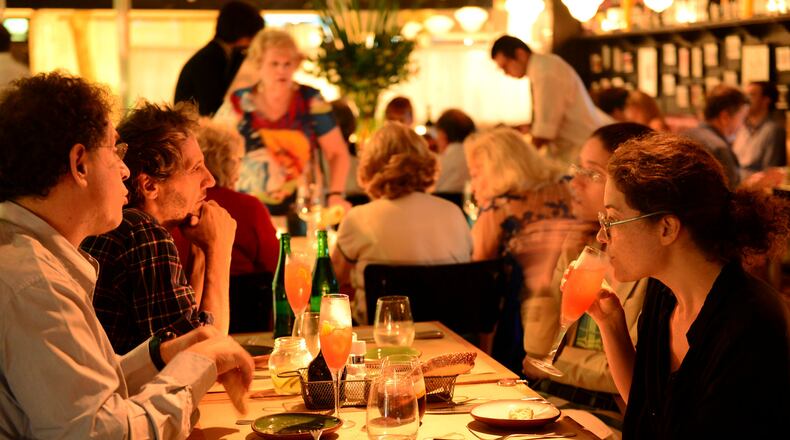On a recent Friday night, a small group stood outside Mishiguene in Buenos Aires, chatting and sipping digestifs after an opulent 12-course tasting menu. Not five minutes had passed when a fellow diner opened the door and bellowed: “Come back in, you have to see this!” The restaurant’s chef, Tomás Kalika, had momentarily stopped dinner service to introduce an accordionist and a clarinetist who began to play joyous klezmer songs, eventually bringing patrons to their feet.
Mishiguene (mishiguene.com) has caused quite a stir in the local dining scene, and not just because of its festive Fridays. When it opened in late 2014, it generated significant buzz as the first restaurant in Argentina to offer modern Jewish cuisine, which translates into a creative menu that draws inspiration from Eastern Europe, Africa and the Middle East. In a city known almost exclusively for its (excellent) barbecued meats and pastas, Mishiguene’s success points to a culinary renaissance.
“At first we had some detractors, especially from Buenos Aires’ Jewish community, because every grandmother thinks she makes the best gefilte fish,” said Kalika, who worked in Israel with one of that country’s top chefs, Eyal Shani. Kalika updated the dish by cooking the fish sous-vide, wrapping it in a sheet of cooked carrots and serving it over a horseradish and beet sauce. “But I think the city is finally ready to be challenged when it comes to food.”
Mishiguene is not the only restaurant that’s bringing new flavors to Buenos Aires. In fact, some of the most talked-about restaurants opened in the last few years serve food from faraway destinations like Southeast Asia, Japan, the Middle East and the American South — food that didn’t exist here, was hard to find before or was just not very good. While the Argentine capital has long been considered one of the most cosmopolitan cities in Latin America, it seemed to lack an appetite for culinary diversity.
“Luckily, Argentines are opening up their palates and being more brave,” said Liza Puglia, an owner of Nola (nolabuenosaires.com), a gastro pub that serves Louisiana specialties. Puglia, who grew up in New Orleans and became a chef in New York, sized up the local market by opening a puerta cerrada, or closed-door restaurant that’s like a supper club, in 2012. Her gumbo and fried chicken were immediate hits among expatriates and travelers. And it didn’t take long for porteños, as residents of Buenos Aires call themselves, to show an earnest interest in Cajun classics.
Two years later, she and her Argentine husband set up shop in the neighborhood of Palermo, in a cozy space where the deep fryer is constantly churning out buttermilk-battered chicken, enhanced by house-made sauces with names like crazy garlic. “Porteños are trend followers, and they are hungry for change,” Puglia said.
Three blocks away from Nola is Gran Dabbang (grandabbang.com), another recently opened restaurant whose menu includes recipes from India, Thailand and beyond. The chef, Mariano Ramón, acquired a taste for global flavors while working in New Zealand with Peter Gordon, considered a father of fusion cuisine, and continued his training in kitchens throughout southern Asia. In a casual dining room decorated with wooden tables and black pendant lights, Ramón offers dishes like chard pakoras with carrot chutney, raita and sriracha, and roasted quail marinated in ginger and garlic and served with a yogurt tahini sauce.
Even some of the city’s most established chefs have spiced up their style. Martín Rebaudino, the former head chef at Oviedo, a classic restaurant heavily influenced by Spain and Italy, struck out on his own in 2014 so he could let his imagination “run free.” At Roux(rouxresto.com), Rebaudino’s spot in Recoleta, an elegant residential neighborhood, the food is not so easy to categorize.
Ingredients are carefully sourced from across Argentina, cooking techniques are modern, and dishes could be described as Mediterranean, but there are also flavors from Asia, the Middle East and various corners of Latin America. Among the appetizers on the seasonal menu is a couscous salad with prawns, baby squid and cured trout, served over a thick cilantro cream, and among the entrees, a seared yellowfin tuna served with an avocado-wasabi purée.
“I’ve seen a complete change from when I arrived in Buenos Aires in 2006,” said Allie Lazar, an American writer who blogs about local restaurants at Pick Up the Fork (pickupthefork.com). “The options were pretty much limited to what I call the three P’s: parrilla, pasta and pizza. Now there’s true variety.”
About the Author
The Latest
Featured


